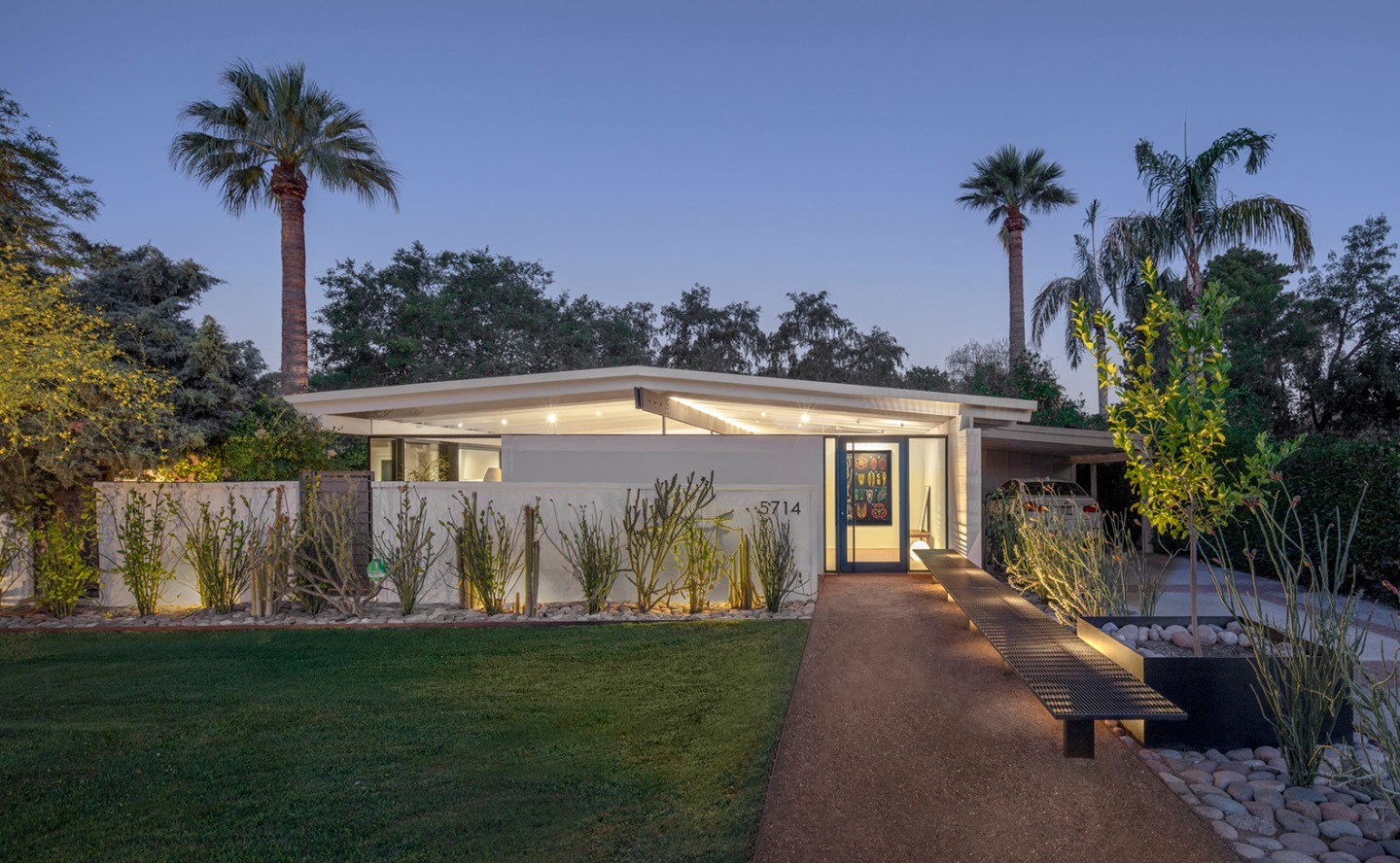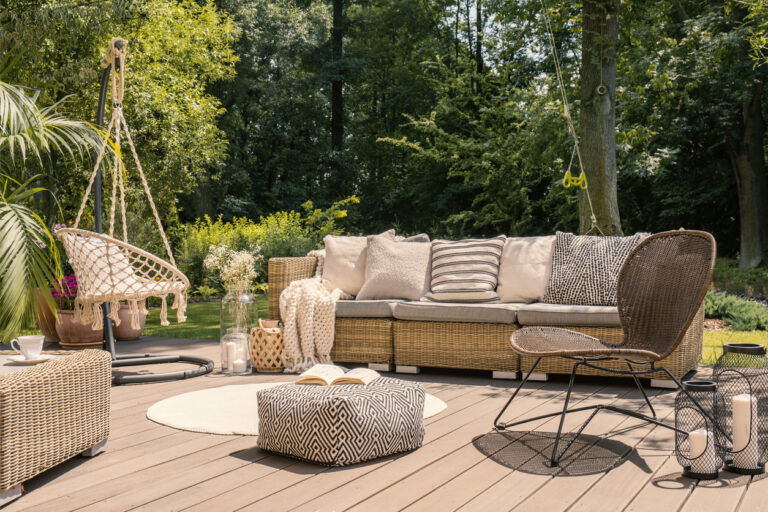Tennis courts become key selling points to any property and immediately increase the value of a home. Although, many wonder what outdoor surface is the best for a backyard to maintain durability while providing benefits for the player.
The best tennis court surface will be the one that is compatible with the weather conditions. The most common type of hard court is made from asphalt or concrete, although very durable and easy to maintain, there are many downsides to this surface.
Another surface to consider that is easy to maintain is grass–not real grass, synthetic grass. Using real grass for tennis courts is rarely used because they require extreme amounts of maintenance and care, but synthetic gives a similar play experience to real grass; however, with less maintenance.
The last surface to consider for your outdoor tennis court is clay. While clay is expensive and requires a lot of watering maintenance to prevent the surface from drying out, there are more recent companies developing alternatives to clay with similar playing characteristics.
What factors to consider next when building an outdoor tennis court in a backyard?
With any large project, the first step is to understand your project’s local building code and ordinances. To find local building codes, Municode offers a free online library to navigate codes by state, city or town with a search bar to filter landscape related codes. Be sure to locate and know if the code requires some of the following, but not limited to: the properties setbacks, impervious pavement calculations, vegetation screening, fencing, lighting, etc.
Once you know the local building codes, sizing the court on the site is important to the function of the site. An outdoor tennis court is typically 60 feet by 120 feet and can be used for other sports like basketball, volleyball, skateboarding, inline hockey, and futsal. Having a multi-use court that satisfies more sports in one single size court is key to maximizing the overall function of the yard.
Orientation of the tennis court is also key because it allows an equal opportunity to complete without sun glare. The ideal orientation of the court that will maximize sun exposure should be oriented north-south and the base should be made of solid concrete blocks. A good foundation will help the tennis court last for many years.
Click here to read the “Top Differences Between a Landscape Architect and a Landscape Designer”.
What are the best surfaces for an outdoor sports court?
There are three basic types of outdoor Tennis Court surfaces
- Hardcourt – which consists of concrete or asphalt
- Grass – real or synthetic
- Clay – orange or green
HARDCOURT / Plexipave
Hard courts are a great option for a home or business. They are made of uniform, rigid materials, include an acrylic layer and offer a high bounce, fast paced experience. While these surfaces tend to be expensive, they can be easily maintained. A hard court is the most durable and cost-effective option for outdoor tennis courts.
Founded in 1953, California Sports Surfaces is the “first and only surface manufacturer to be awarded the status of International Tennis Federation Recognition Elite Silver and surfaces can be seen in world-renowned events, like the U.S Open”.
Plexipave has been used in the Melbourne Grand Slam Tournament since 2008. This surface is safe for use outdoors, is easy to maintain, and is environmentally friendly. Its high-quality resins and latex-bound sand provide consistent bounce, spin, and grip. The material also reduces the wear on tennis balls. Therefore, you’ll notice fewer cracks and breaks when playing on your tennis court.
Plexipave’s surface provides a multi-purpose range of sports to be played on like Basketball, Pickleball, Roller Sports, Netball, and Tennis.
CLAY / Har-Tru
A Har-Tru tennis court is made of a single layer of green clay. This material is a billion-year-old metabasalt found in the Blue Ridge Mountains of Virginia. It is a very hard and angular stone that provides exceptional durability and resilience. It is crushed into precise portions and installed on a porous base of crushed stone aggregate. When you’re deciding on the right surface for your new tennis court, ask your local Har-Tru distributor for recommendations.
Har-Tru courts provide a number of benefits to tennis players and court owners. HAR-TRU is extremely durable and requires only minimal maintenance so the material will look great for years with simple and consistent care. More specifically, this bare tennis court should not require regular sweeping or regular washing. Instead, you will only need to maintain it a few times a year. Overall, with proper care, the clay court won’t crack, which is a major benefit to this type of surface.
GRASS / Synthetic Grass
Compared to its hardcourt alternative with high bounce and being fast paced, grass offers the fastest court with the lowest bounce experience.
The cushion court tennis surface ProKramer by NGI Sport was developed by former world champion Jack Kramer to offer balanced playing characteristics throughout the entire court. This surfacing system contains short, dense fibers that provide true grass-like ball response and excellent traction. It is an ideal choice for schools and other facilities with budget-conscious tennis players. To learn more about the ProKramer surfacing system, read on.
The Plexicushion substrate is a special blend of latex and rubber that attenuates body impact and reduces muscle fatigue. This patented surfacing system also features a Plexipave Surface that provides a consistent bounce and long-lasting color. The Plexicushion substrate allows tennis courts to meet a variety of playing specifications and climates. The Plexipave surfacing is ideal for multi-game courts and residential applications.
ProCourt is the most advanced synthetic grass surfacing system available. It is ideal for tennis courts at all competitive levels. This surfacing system plays at medium speed and features specialized PE turf fibers and high-quality infill. The Plexicushion tennis court surface provides the best possible performance for players and requires minimal maintenance on the part of owners. It is a great choice for schools and other sports facilities looking to improve the overall performance of their facilities.
Other Options for durable, versatile and high performance outdoor tennis court surfaces:
- The PowerGame outdoor modular game court surface
- ProStep
- Flex Court surfaces
- Classic Turf
How much does an outdoor sports court cost?
The outdoor Tennis Court cost can range anywhere from $25,000 to $30,000 depending on the size. The cost can be further increased by installing a sound system or other special features. Here are some things to consider when determining the exact cost of your outdoor court.
- The surface of the court. The surface of your outdoor court will depend on your budget and your personal preference. Soft surfaces are usually cheaper and more convenient to play on. However, they require more maintenance, especially if you have a bad knee. Hard surfaces, on the other hand, require less maintenance. Therefore, if you’re building a tennis court for a school or community, a hard surface may be the best option.
- The cost of the court installation. A quality outdoor tennis court will cost anywhere from $300 to $4,000. A professional installation will require specialized equipment and tools, and the cost is generally eight to ten times higher than a DIY installation. If you want to save money, you can mix your own concrete, but this will require you to spend a lot of time. If you’re building a tennis court for a community or for recreational purposes, a good sound system will be essential.
- The cost of landscaping. Landscaping a tennis court will cost around $1,000 and requires frequent weed-free care. If you’re on a budget, you might want to skip this step. Asphalt tennis courts can last for years, but they require extensive preparation, such as a thorough grading and clearing of land to ensure your outdoor tennis court will be ready to play.
- The cost of soil preparation. Soil preparation will also play an important part. If you have sandy or peat soil, you will need to dig it up first to prevent it from shifting. Then, you will need to install a stone drainage medium and French drains. These two steps will determine the total outdoor Tennis Court cost.
A tennis court’s cost varies considerably because the price of an outdoor Tennis Court is dependent on the size, location, and features.
The average 78×27-foot court costs $15,000, while a large lighted court can cost up to $30,000. You’ll need to hire a professional designer to create the design, which will help you decide on the final cost. You can also choose to add a fence and outdoor lighting to your tennis court which will further increase the price.
Fencing can cost you anywhere from $500 to $2000, but the construction process will take several weeks. A tennis bubble will help you play during the rainy season while a permanent inflatable air tent will be over $100,000. Additional installations, such as a net will also add approximately $300 to the overall cost. You’ll also need to purchase the net and ensure it’s installed properly.
What if I don’t have enough space for a tennis court?
If you want your kids to have the opportunity to play on a tennis court, consider installing an outdoor half sports court or a basketball court. It has all the amenities of a full basketball court, but it is less expensive than a full outdoor court. In addition to being a great option for families, a half basketball hoop also helps young athletes develop their skills. Aside from being easy to maintain, this type of basketball court is a great addition to any backyard.
To build an outdoor half basketball court, you need a level surface, and a solid structure. You can install snapping tiles on top of a concrete or sport base. These surfaces cost around $3,500 to $4,000 a square foot. You should consider the installation process and the materials before you decide to purchase them. If you’re unsure of the amount of labor involved, you can always hire a contractor.
In general, the cost of installation for any size basketball court, outside or inside, will cost anywhere from $17,200 to $76,000. A standard 94 by 50-foot court is 4700 square feet. Therefore, a 30 by 30-foot would be a great size for a half. All of this will depend on size, location and the decision to use a contractor or DIY.
One of the most important parts of an outdoor half basketball court is a basketball hoop. A good basketball hoop will cost you anywhere from $8,000 to $38,000, depending on the size of your backboard and hoop extension. A professional will also help you paint the game lines on the tiles, which should be included in the price. If you’re still unsure about what it will cost, request a free estimate and consultation.
When complete with any multi-purpose court, outdoor tennis court lighting is key for creating a safe environment for players. Most indoor recreation facilities use multi-sport lighting, which minimizes glare and provides an appropriate level of illumination. In addition to providing adequate illumination, outdoor Luminaires should be positioned high enough so that they provide a consistent level of light, enabling players to judge the speed and trajectory of the ball. To get the best results, consider installing several Luminaires in the same location.
Click here to see sport court inspiration on our Pinterest Page!
Conclusion
Tennis courts add value to any home tangibly and intangibly. The decision to add one will come as a reward after detailed decisions about installation are made. There are also other options such as a multi-purpose court or half basketball court if you don’t have the space.



















